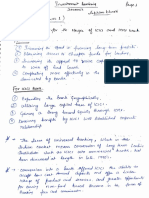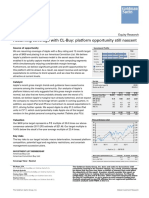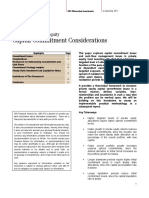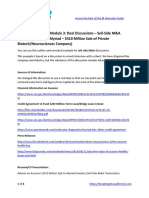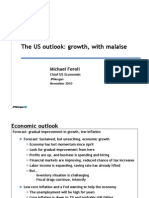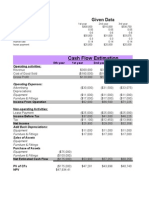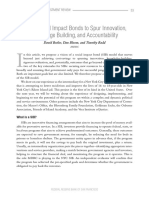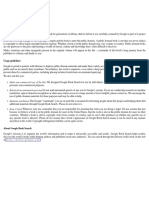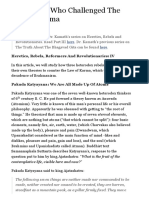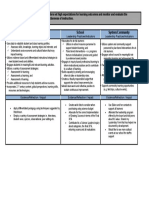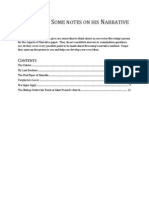An Introduction to Social Impact Bonds
Cason Schmit, J.D.
ORISE Legal Fellow
Public Health Law Program
Office for State, Tribal, Local and Territorial Support
Centers for Disease Control and Prevention
April 2014
Office for State, Tribal, Local and Territorial Support
Public Health Law Program
�Disclaimer
The contents of this presentation do not represent
official CDC determinations or policies.
The findings and conclusions in this report are those of the author and
do not necessarily represent the official position of the CDC.
The contents are for educational purposes only
and are not intended as a substitute for
professional legal advice.
Always seek the advice of an attorney
or other qualified professional with any questions
you may have regarding a legal matter.
2
�Innovations in Public Health Financing
INTRODUCTION TO
SOCIAL IMPACT BONDS
�Presentation Overview
q
q
q
q
q
q
q
A social impact bond (SIB) analogy
What are SIBs and why are they important?
Considerations in creating a SIB program
SIBs in progress and new applications
Laws and proposed laws addressing SIBs
Concluding remarks
Questions
�An Analogy
�The Deal
q
Problem
Cost of 30 new energy efficient
bulbs is $120
Offer
I replace all of your bulbs for free
You give me nothing upfront
Catch
If you get energy savings of $200
($100 per year for 2 years), then
you give me $150 after 2 years
If not, I get nothing and take my
bulbs back and return your old
bulbs
�The Deal: A Positive Resolution?
q
Results if successful
For you
Total cost: $150
Total savings: $200
Net benefit: $50
For me
Total cost: $120
Total income: $150
Return on investment: 25%
q
Result if unsuccessful
For you
Go back to old bulbs
For me
Stuck with new bulbs and costs
�Pay for Success
q Pay for success (PFS) arrangements
Payments are based on program outcomes
example: SIBs
�Current Problems in Social and Public Health Services
q
q
q
Limited resources
Focus on remediation not prevention
Pay for services
Services may not achieve desired outcomes
Lack of data on effectiveness of programs
�Significance of PFS and SIBs
q
Social ills and public health problems cost money
Example: Homelessness ($67 billion)1
Shelter costs
Welfare
Medicaid
Etc.
Many governments lack the funding needed to address problems
q
PFSs and SIBs can transform those costs into potential profit
If profitable, PFSs and SIBs can leverage large amounts of private capital
into Social and Public Health Programs
Can create a public policy trifecta
Win-win-win for government, private sector, and vulnerable populations
Laura Callanan, Jonathan Law, Lenny Mendonca, From Potential to Action: Bringing Social Impact Bonds to the US, McKinsey & Company, 8
(2012)
�What Are SIBs?
q
Definition
Financing mechanisms used to raise upfront funding for social and
public health preventative interventions from private investors
Leverage the anticipated savings due to prevention as a source for
financial rewards to the investors
Rewards due if and only if the intervention succeeds in reaching
predetermined benchmarks, thereby shifting the financial burden of
success to the investors
Definitional problems
Difficulties: novelty, flexibility, complexity, and terminology
�Why Is This Model Attractive?
q
Governments
Philanthropic investors
Limited financial risk
Funds prevention/outcomes
Potential budget savings
Encourages efficiency
Intervention providers
Stable multiyear funding
Builds relationship with
government
Amplify impact
Investors
Performance evaluated
Opportunity to scale initiatives
Program-related investments
Fosters collaboration
Commercial investors
Promising new market for
commercial profit
Growth to social services
q
Intervention recipients
Access to needed programs
Jeffrey Liebman and Alina Sellman, Social Impact Bonds: A Guide for State and Local Governments, Harvard Kennedy School Social Impact
Bond Technical Assistance Lab, 9 (2013)
Jane Hughes and Jill Scherer, Foundations for Social Impact Bonds: How and Why Philanthropy Is Catalyzing the Development of a New
Market, Social Finance, 1723 (2014)
�Promising SIB Applications
q
Recidivism
UK, NYC, MA, NY
q
At-risk youth services
SC
q
UK, NY, MA, Australia
q
Homelessness
Workforce development
Early childhood services
and education
Diabetes
Israel
U.S. Dept of Labor
q
Asthma reduction
Fresno, CA
UK, MA
q
Pre-natal care
Elderly services
UK, S. Korea
Others likely in the future
Salt Lake City, Utah
Jeffrey Liebman and Alina Sellman, Social Impact Bonds: A Guide for State and Local Governments, Harvard Kennedy School of Government,
20 (2013).
�A Structural Example
SOCIAL IMPACT BONDS
�An intermediary
negotiates with SIB
backer for SIB repayment
terms
Intermediary/Bond
Issuers
Typically a Non-Profit
SIB Backer
Typically a Government
�Investors/Bond
Holders
Intermediary/Bond
Issuers
Intermediary seeks initial
financing from private
investors by issuing SIBs
SIB Backer
�Credit
Enhancement
Investors/Bond
Holders
Intermediary/Bond
Issuers
To make investment
more attractive,
intermediary can seek
credit enhancement (CE)
to lower the risk of failure
to investors
SIB Backer
�Similar to insurance, CE returns a
portion of investment if SIB
program fails
Credit
Enhancement
Investors/Bond
Holders
Intermediary/Bond
Issuers
SIB Backer
�Credit
Enhancement
Intermediary
contracts with
intervention provider
Investors/Bond
Holders
Intermediary/Bond
Issuers
Intervention
Provider
SIB Backer
�Credit
Enhancement
Investors/Bond
Holders
Intermediary/Bond
Issuers
Provides
intervention to
target population
Target
Population
Intervention
Provider
SIB Backer
�At pre-determined times,
independent entity evaluates the
programs success or failure
Credit
Enhancement
Investors/Bond
Holders
Intermediary/Bond
Issuers
Target
Population
Intervention
Provider
Independent
Evaluator
SIB Backer
�If SIB Program Fails . . .
�Evaluation reveals that
program failed to reach
benchmarks for success
Credit
Enhancement
Investors/Bond
Holders
Intermediary/Bond
Issuers
Target
Population
Intervention
Provider
Independent
Evaluator
SIB Backer
�Program Failure
Credit
Enhancement
Investors/Bond
Holders
Intermediary/Bond
Issuers
Target
Population
Intervention
Provider
Independent
Evaluator
SIB Backer
Backer not
obligated to
reimburse
�If used, CE partially repays
investors, reducing impact of
failure
Credit
Enhancement
Investors/Bond
Holders
Intermediary/Bond
Issuers
Target
Population
Intervention
Provider
Program Failure
Independent
Evaluator
SIB Backer
�Investors suffer any
additional loss
Credit
Enhancement
Investors/Bond
Holders
Intermediary/Bond
Issuers
Target
Population
Intervention
Provider
Program Failure
Independent
Evaluator
SIB Backer
�If SIB Program Succeeds . . .
�Evaluation reveals that
program has reached success
benchmarks
Credit
Enhancement
Investors/Bond
Holders
Intermediary/Bond
Issuers
Target
Population
Intervention
Provider
Independent
Evaluator
SIB Backer
�Program Success
Credit
Enhancement
Investors/Bond
Holders
Intermediary/Bond
Issuers
Target
Population
Intervention
Provider
Independent
Evaluator
SIB Backer
SIB backer pays intermediary
the cost of initial investment
plus any agreed upon
premium
�Intermediary repays
SIB holders plus any
due premium
Credit
Enhancement
Investors/Bond
Holders
Intermediary/Bond
Issuers
Target
Population
Intervention
Provider
Program Success
Independent
Evaluator
SIB Backer
�Program Success
Credit
Enhancement
Investors/Bond
Holders
Intermediary/Bond
Issuers
Target
Population
Intervention
Provider
Independent
Evaluator
SIB Backer
�Program Success
Credit
Enhancement
Investors/Bond
Holders
Intermediary/Bond
Issuers
Target
Population
Intervention
Provider
Independent
Evaluator
SIB Backer
�Program Success
Credit
Enhancement
Investors/Bond
Holders
Intermediary/Bond
Issuers
Target
Population
Intervention
Provider
Independent
Evaluator
SIB Backer
�CONSIDERATIONS FOR CREATING A SIB
�Considerations for a Successful SIB
q
q
q
q
Definitions
Evaluation
Risk
Potential savings
�Considerations for a Successful SIB: Definitions
q
The elements of the SIB should be carefully defined
Who is the target population?
What does success look like?
Outcome performance goals need to be
o Clear
o Objective
o Measurable
o Non-debatable
o Achievable
What can be saved?
Maria Hernandez, S. Len Syme, and Rick Brush, Impact Investing in Sources of Health, Collective Health, 5 (2012), available at
http://collectivehealth.files.wordpress.com/2012/04/impact-investing-in-health_tce-paper_feb-2012.pdf.
Steven Godeke and Lyel Resner, Building a Healthy & Sustainable Social Impact Bond Market: The Investor Landscape, Godeke Consulting,
(2012)
�Considerations for a Successful SIB: Evaluation
q
Independent evaluators
Intermediary may have own evaluators
Reliable and valid methodology is crucial
Measurable evaluation criteria
Evaluation critical to fair outcomes
�Considerations for a Successful SIB: Risk
q
Available data helps define the risks
Model effectiveness of the intervention
Execution effectiveness of the intervention as provided
Proven v. promising
Focus on proven interventions minimizes the model risk
Promising interventions may still attract investors if potential return is
significant
Some suggest SIBs use proven interventions until the SIB concept
demonstrates success
Credit enhancement
Strategies to improve the risk-benefit outlook for investors, e.g.,
insurance
�Considerations for a Successful SIB: Potential Savings
q
q
q
q
Significant potential savings are crucial to attract investors
Important that SIB deliver savings in excess of cost
Savings should be identifiable and supported by data
Savings justify bringing interventions to scale
�Illustration of Bankable Savings for Recidivism SIB
Callanan, Jonathan Law, Lenny Mendonca, From Potential to Action:
Bringing Social Impact Bonds to the US, McKinsey & Company, 49 (2012)
�SIB Considerations
q
Legal issues
Appropriations
Government silos
q
q
Standardization
Other critiques
Shifting attention and resources away from
other important problems
Possible investor influence over intervention
delivery
Inherent inefficiencies
�Current State of SIBs
SIBS IN PROGRESS AND
NEW APPLICATIONS
�United Kingdom Inmate Recidivism
q
Worlds first SIB started in Peterborough in 2010
$8M initial investment raised by Social Finance
Goal
Reduce inmate reoffending rate by 7.5%
Interim results (Nov. 2013)
12% decrease recidivism in contrast with 11% increase nationally
Intervention
Social services to 3,000 short-sentence male inmates
Evaluation period
Outcomes evaluated years 4, 6, and 8
Jeffrey Liebman and Alina Sellman, Social Impact Bonds: A Guide for State and Local Governments, Harvard Kennedy School Social Impact
Bond Technical Assistance Lab, 10 (2013)
Nicky Stubbs , Peterborough social impact bond seeing positive results, Blue & Green Tomorrow (Nov. 2, 2013), available at
http://blueandgreentomorrow.com/2013/11/02/peterborough-social-impact-bond-seeing-positive-results/.
�New York City Juvenile Recidivism
q
q
In 2012, New York City launched the first SIB in the US
Goals
Graduated benchmarks (8.5% to 20.0% recidivism rate reductions)
Payment range: $4.8M (8.5% reduction) to $11.7M (20% reduction)
Intervention
Social services to 3,000 adolescent men per year through 2015
Investment
MDRC raised $9.6M from Goldman Sacs
Credit enhancement
Bloomberg Philanthropies providing $7.2M guarantee
Jeffrey Liebman and Alina Sellman, Social Impact Bonds: A Guide for State and Local Governments, Harvard Kennedy School Social Impact
Bond Technical Assistance Lab, 1011 (2013)
�Massachusetts Homelessness
q
Goal
Reduce costs associated with chronic homelessness, specifically costs
associated with mental and physical health, jail use, and shelter use
Intervention
Supportive housing for the chronically homeless
Evidence Supporting Intervention Model
2009 program found mean annual Medicaid costs dropped from
$26,124, to $8,500 after supportive housing, estimated $1.7M in
Medicaid savings
Joe Finn and Jeff Hayward, Bringing Success to Scale: Pay for Success and Housing Homeless Individuals in Massachusetts , COMMUNITY
DEVELOPMENT INVESTMENT REVIEW, FEDERAL RESERVE BANK OF SAN FRANCISCO, 127 (2013), available at
http://www.nj.gov/state/programs/pdf/faith-based-investment-success-financing.pdf.
Massachusetts First State in the Nation to Pursue Pay For Success Social Innovation Contracts, Exec. Office for Admin. and Finance, (Jan. 18,
2012), available at http://www.mass.gov/anf/press-releases/2012/ma-first-to-pursue-pay-for-success-contracts.html
�Fresno, California Asthma Emergency Prevention
q
Nongovernmental SIB arrangement
Financial stakeholders back the SIB
Problem and intervention
Estimated $87M in annual costs associated with asthma emergencies
ED visits, hospitalizations, and lost worker productivity
Targeted home based interventions to reduce asthma triggers
q
Costs
Intervention expected to lower healthcare costs of target population 41%
Estimated financial savings to backers
Medi-Cal ($3M), local employers ($2.3M), healthcare providers ($1M )
Rick Brush, Can Pay for Success Reduce Asthma Emergencies and Reset a Broken Health Care System?, COMMUNITY DEVELOPMENT INVESTMENT
REVIEW, FEDERAL RESERVE BANK OF SAN FRANCISCO, 108 (2013), available at http://www.nj.gov/state/programs/pdf/faith-based-investmentsuccess-financing.pdf.
Maria Hernandez, S. Len Syme, and Rick Brush, Impact Investing in Sources of Health, Collective Health (2012), available at
http://collectivehealth.files.wordpress.com/2012/04/impact-investing-in-health_tce-paper_feb-2012.pdf.
�South Carolina Early Childhood Services
q
2013 study suggests that a PFS is a
feasible mechanism to improve early
childhood outcomes2
Intervention: nursefamily partnerships
(NFP)
House visits and services to first-time, lowincome mothers
Measurable outcomes
Measurable improvements possible in health,
education, and family prospects
Pre-term births suggested as a bellwether
index
Golden, Megan, et al., Using Pay for Success Financing to Improve Outcomes for South Carolinas Children: Results of a Feasibility Study,
Institute for Child Success (2013).
�Israel and Type 2 Diabetes
q
Proposed intervention
One-year intensive intervention and two-year follow-up
Healthy living and personal fitness programs to high-risk pre-diabetics
Measurement
Number of type 2 diabetics relative to a control group
Number of healthy states produced relative to a control group
Outcome payments
Reduction in medical expenditures
Reduction in disability expenditures
Increase in economic productivity
Dr. Ophir Samson, Planning of a Social Impact Bond to Reduce Development of Type 2 Diabetes in High-risk Pre-diabetics, Presentation to the
Social Impact Investment Taskforce Established by the G8, (Dec. 5 2013), available at
http://www.socialfinance.org.il/files/files/Social%20Finance%20Israel%20%20Social%20Impact%20Bond%20to%20reduce%20development%20of%20type%202%20diabetes%20in%20high-risk%20prediabetics.pdf.
�EXISTING AND PROPOSED LAWS
�Examples of Existing Laws
q
California
CAL. WELF. & INST. CODE 14127.4
Enables state to enter into risk-sharing and social impact bond program
agreements
Connecticut
CONN. GEN. STAT. ANN. 4-68aa
Authorizes use of social investment vehicles
Creates social innovation account
Massachusetts
Social Innovation Financing Trust Fund MASS. GEN. LAWS ch. 10, 35VV(c)
Pay for performance obligations constitute general obligations backed by the full
faith and credit of the commonwealth
�Examples of Existing Laws (Cont.)
q
Minnesota
Pay for Performance Act MINN. STAT. ANN. 16A.93 et al.
Pilot program to test feasibility and desirability of using state
appropriation bonds to pay for certain services based on performance and
outcomes for the people served
Creation of special appropriation bond proceeds account
Pennsylvania
Innovate in PA Fund 72 PA. STAT. ANN. 8811-F (c)(2)
Enables consideration of impact investments based on performance
�Examples of Proposed Laws
q
California Senate Bill No. 593 (2013)
Requires director of the Office of Planning and Research to identify at
least three proposed social impact partnerships to the Legislature
each year.
California Senate Bill No. 594 (2013)
Workforce Development Bond
Hawaii House Concurrent Resolution No. 119-13 (2013)
Requested feasibility study for SIBs to fund early learning programs
�Examples of Proposed Laws (Cont.)
q
Maryland Senate Bill No. 434 (2013)
Request for proposals
Maryland House Bill No. 517 (2013)
State Board of Education Request for Proposals for SIBs
Nebraska Legislative Resolution No. 279 (2013)
Requires the legislative Judiciary Committee to conduct an interim
study of SIBs
New Jersey Assembly Bill No. 3289 (2012)
Five-year SIB pilot program and study
�Examples of Proposed Laws (Cont.)
q
Texas Senate Bill No. 1788 (2013)
Requires a prevention committee to advise on use of SIBs to finance
child abuse prevention programs
Rhode Island Senate Bill No. 2196 (2013)
Five-year SIB pilot program
Vermont House Bill No. 625 (2011)
Authorizes committee to determine whether SIB opportunities exist
Washington House Bill No. 2337 (2013)
Establishes social investment steering committee
Washington D.C. Legislative Bill No. 125 (2013)
Social Impact Financing Amendment Act of 2013
�International Laws and Proposed Laws
q
Alberta, Canada
2014 Bill 1 creates $1B Endowment for Social Innovations
2014 Bill 1, Savings Management Act, Second Session, 28th Legislature, 63 Elizabeth II (2014)
Announcements: Putting Albertas growing savings to work for our future, (Mar. 4, 2014) (avail.
http://alberta.ca/release.cfm?xID=359728D5EF19F-D565-C959-7EFD9867C9BC38F7).
�Social Impact Bond Viability
CONCLUDING REMARKS
�Market Viability of SIBs
From the McKinsey & Co. United
States SIB market analysis
Our research suggests that SIBs have specific
benefits and that the right conditions are in
place today to implement SIBs: evidencebased social interventions already exist, there
is sufficient stakeholder capacity, and there is
real interest and momentum to make SIBs a
reality. But turning potential into action will
require a clear choice to move ahead and
concerted effort to implement this new tool:
stakeholders must overcome several
challenges, a number of proof points must be
demonstrated, and making SIBs more
widespread will require some
standardization.
Laura Callanan, Jonathan Law, Lenny Mendonca, From Potential to Action: Bringing Social Impact Bonds to the US, McKinsey & Company, 54
(2012)
�Early Evaluations
UK Justice Secretary Chris Grayling
reacting to an interim report
suggesting positive outcomes from
worlds first SIB in Peterborough
The message is clear our reforms
are the right approach and will help
us end the pernicious cycle of
reoffending, keeping our
communities safer.
Nicky Stubbs , Peterborough social impact bond seeing positive results, Blue & Green Tomorrow (Nov. 2, 2013), available at
http://blueandgreentomorrow.com/2013/11/02/peterborough-social-impact-bond-seeing-positive-results/.
�Selected Resources
CDC Public Health Law Program Research Anthology
Descriptive
Jeffrey B. Liebman, Social Impact Bonds, CENTER FOR AMERICAN PROGRESS (February 2011),
www.americanprogress.org/issues/2011/02/pdf/social_impact_bonds.pdf
Technical guides
http://www.cdc.gov/phlp/docs/sib-researchanthology.pdf
Lisa Barclay & Tom Symons, A Technical Guide to Developing Social Impact Bonds. SOCIAL FINANCE (January 2013),
www.socialfinance.org.uk/resources/social-finance/technical-guide-developing-social-impact-bonds
Steven Godeke, & Lyel Resner, Building a Healthy & Sustainable Social Impact Bond Market: The Investor Landscape,
GODEKE CONSULTING (2012), www.rockefellerfoundation.org/media/download/6a7eba56-aa6f-47bf-a451-f883b8b4ccc5
Jeffrey Liebman, & Alina Sellman, Social Impact Bonds: A Guide for State and Local Governments, HARVARD KENNEDY
SCHOOL SOCIAL IMPACT BOND TECHNICAL ASSISTANCE LAB (June 2013), payforsuccess.org/sites/default/files/social-impactbonds-a-guide-for-state-and-local-governments1.pdf
Commentary
Pay for Success Financing, 9 COMMUNITY DEVELOPMENT INVESTMENT REVIEW 1, 1137, (Ian Galloway ed. 2013),
www.nj.gov/state/programs/pdf/faith-based-investment-success-financing.pdf
�QUESTIONS?
�Thank you!
Cason Schmit
CSchmit@cdc.gov
(404) 498-2387
For more information, please contact CDCs Office for State, Tribal, Local and Territorial Support
4770 Buford Highway NE, Mailstop E-70, Atlanta, GA 30341
Telephone: 1-800-CDC-INFO (232-4636)/TTY: 1-888-232-6348
E-mail: OSTLTSfeedback@cdc.gov
Web: http://www.cdc.gov/stltpublichealth
The findings and conclusions in this presentation are those of the authors and do not necessarily represent the official position of the
Centers for Disease Control and Prevention.
Office for State, Tribal, Local and Territorial Support
Public Health Law Program





